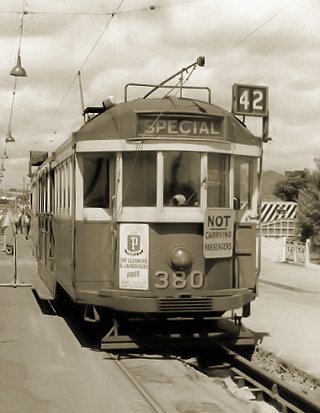Melbourne Tram Museum
- Follow Melbourne Tram Museum on Twitter
- Follow Melbourne Tram Museum on Facebook
- Follow Melbourne Tram Museum on Instagram
- Follow Melbourne Tram Museum on Pinterest
- Follow Melbourne Tram Museum on Tumblr
- Subscribe to Melbourne Tram Museum's RSS feed
- Email Melbourne Tram Museum
Melbourne & Metropolitan Tramways Board W Class No 380
To enable the conversion of the Melbourne cable tram system to electric traction, and to fulfil its plans for the massive expansion of the electric tramway system, the Melbourne & Metropolitan Tramways Board (M&MTB) needed a cost-effective, robust and high capacity tramcar design suitable for mass production. The Melbourne W class – as represented by No 380 – was the answer to this problem. This tram therefor represents a critical stage in Melbourne’s tramway history.
 M&MTB No 380 in Miller Street, Preston, January 1967.
M&MTB No 380 in Miller Street, Preston, January 1967. - Photograph courtesy Mal Rowe.
No 380 was produced as one of 200 trams constructed to the original W class design for the M&MTB between 1923 and 1926. It was built by the M&MTB’s Holden Street Workshops and entered service on Christmas Day 1925. These cars were designed to be easily mass-produced, and formed the basis of what was to become the internationally-recognised symbol of Melbourne, the W type tramcar, which proliferated into twelve different major versions and over 750 vehicles.
The W class trams were constructed by the M&MTB in both the Holden Street and Preston Workshops, as well as by the private manufacturers James Moore of South Melbourne and Holden Body Builders of Adelaide.
The W class tramcars were identifiable by the three equal-width doorways which could be protected by canvas blinds in the event of inclement weather (not unknown in Melbourne), and by the drop centre wooden seats which were arranged in front-to-back pairs facing the middle of the car. This design was found to be non-optimal for passenger unloading, so all 200 W class tramcars, including No 380, were converted to the W2-style drop centre between 1928 and 1933, being reclassified into that class on conversion. The change resulted in the centre doorway being narrowed with the two outlying doorways being widened, and a rearrangement of the drop centre seats into four back-to-back pairs of seats.
Technically these trams were bogie drop-centre combination tramcars, a design type which was basically restricted to Australia and New Zealand. Mechanically simple and robust, examples of this basic design were in operation for over sixty years in the streets of Melbourne.
No 380 was allocated to South Melbourne, Malvern and Kew Depots during its service life. Unlike most of its sister cars, it was never fitted with multiple head and tail lights. It ended up being allocated to the driver training school at Hawthorn Depot, and in 1988 was restored to original condition as a W class car by Preston Workshops. It was thereafter intermittently used on a range of tourist services.
This important 1920s Melbourne icon is is owned by VicTrack on behalf of the Government and people of Victoria and is now on display as part of the collection of the Melbourne Tram Museum.
Technical details
| Motors: | 4 x 40hp (MV 101) |
| Controller: | GE K35JJ |
| Truck: | M&MTB No 1 |
| Passengers: | 52 (seated), 93 (standing) |
| Weight: | 16.8 tons |
| Length: | 48 feet 0 inches |
| Width: | 7 feet 6 inches |
Bibliography
Cross, N., Budd, D., and Wilson, R. (1993) Destination City (Fifth Edition), Transit Australia Publishing
Cross, N., Henderson, R. and Kings, K. (1981) Destination City (Fourth Edition), Australian Electric Traction Association
Jones, R. (2008) Fares Please! An economic history of the Melbourne & Metropolitan Tramways Board, Melbourne Tram Museum